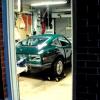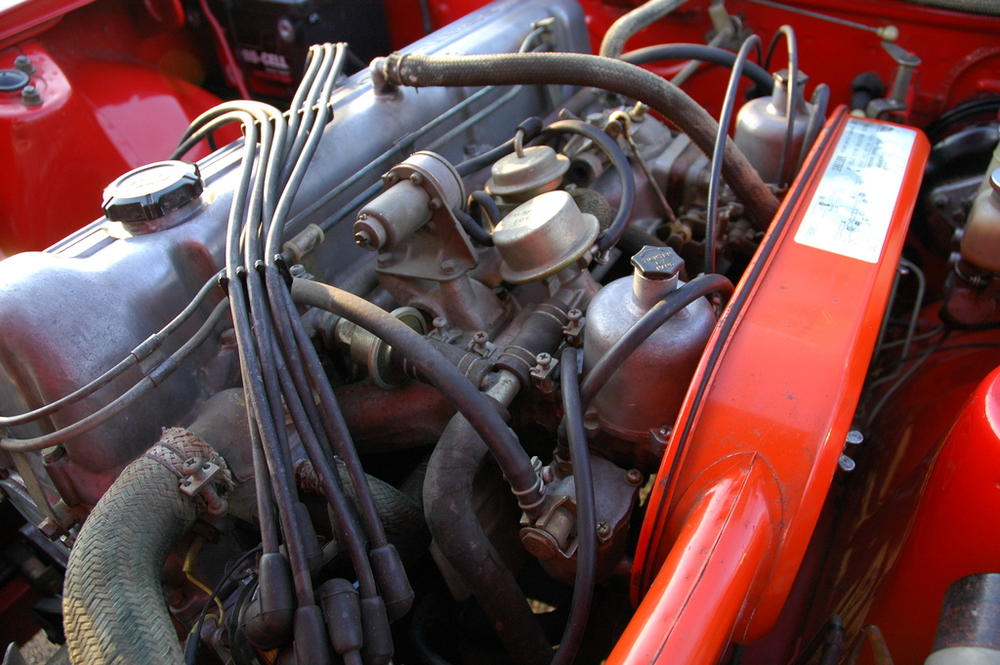Everything posted by Namerow
-
Can some please take pictures of their stock horn locations 75/76 280Z
Not sure about this. I bench-tested my re-built horns independently, off the car, with direct pos and neg connections from a guaranteed 12VDC power supply. They had to be correctly adjusted with the adjustment screw. Move too far in either direction and 'bleat' became 'dink'... or silence.
-
1970 249Z Brake Booster
I got mine (in 2015) from my local NAPA outlet. 6" canister, measured with my vernier caliper. Might have just got lucky, but don't overlook the obvious.
-
Caswell Plating
I hate anecdotal evidence, but I will say again that the variable with the most pronounced effect in my plating experience was the regular addition of of the Caswell 'brightener' liquid to my electrolyte bath. I don't know why. I have no formula or explanation to offer. Alchemy! Sorcery! I too want a Caswell franchise where I can sell overpriced, unexplained chemicals to optimists just like me.
-
Optimal performing exhaust for street
It would be best if the comparison testing was done on the same dyno. Otherwise, the (probably) small differences measured could have to do as much with dyno A vs. dyno B as they do with exhaust system X vs. exhaust system Y. I haven't looked at chassis dyno specs for a long time, but back in my day, the best chassis dynos that speedshops could afford were based on eddy-current absorber technology and IIRC the absolute accuracy was on the order of +/- 5% . Decent repeatability, but only so-so absolute accuracy. The automotive and fuels/lubricants industry R&D labs that I worked with used controllable DC machines, where the accuracy was +/- 0.5%. Those units cost anywhere from $500K to $1 Million. The low-end machines may be better than they used to be, but it's always best to be using the same measurement device if you're looking to detect small differences with confidence.
-
My 240z project
Agree with Grannyknot and Patcon. Maybe it's that clean northwest coastal air. Can I send you a box of my parts that still need plating?
-
High Tone Horn Not Working
If you play with the adjustment screw (X-type panhead machine screw at the 11:00 o'clock position in your picture of the rear face of your horn), you may find an easy solution to your problem. If not, no harm done and you can move on to the next step of your troubleshooting. The adjustment is a bit hair-triggered and requires a little patience to get it right. If your car's PO played with this and lacked patience, he might have just given up and left it in the 'dink' adjustment zone.
-
High Tone Horn Not Working
-
restore ugly valve cover (mistake to media blast?)
I don't have a picture, but my results are pretty much identical to the pix just posted by Siteunseen. It's a 'whiter' look than the OE finish. As an engineer, I respect the advances made in paint chemistry but I'm still skeptical about whether a paint can get the job done in high-visibility underhood applications. Diseazed says his experience supports VHT paint for this application. All I care about is good solutions for all of us. Anyone else with similar positive experiences with VHT paints?
-
restore ugly valve cover (mistake to media blast?)
Of course it looks beautiful. But that's only as long as you never touch it with oil, fuel, or any kind of cleaning solvent.
-
High Tone Horn Not Working
The FSM has some surprisingly detailed instructions on how to tune the horns. Personally, I found the results no better than 'ok', Nevertheless, you should be able to adjust so that you at least get a 'bleat' rather than a 'dink.
-
restore ugly valve cover (mistake to media blast?)
I blast-cleaned my cover using fine-grit glass. Afterwards, I dressed it with 'Gibbs' brand fogging oil (aka 'snake oil'). I'm happy with the result, but it is not an OE look. If you want that, it looks like vapor bla$ting is the way to go. The OE appearance looks 'harder' than what you'll get with typical media blasting, although walnut shells might come closer.
-
Caswell Plating
Many years ago, I was invited to make an inspection tour of a government research facility (big building, big test rigs). It was located about a mile away from two steel mills, separated from them by an open harbor. The facility manager showed me a bunch of expensive electrical panel that he said had been ruined by the SO2 carried in the air from across the harbor.
-
Correct fasteners for Intake and Exhaust Manifolds
The two manifolds on the L24 engine are shown in the parts diagram to be secured with studs at all seventeen locations. However, the engine in my 70 Z uses bolts for the top row (six locations). A spare L24 engine (from a 72 Z that I had as my daily driver back in the 1970's) also used bolts for the top row. I'm 90% certain that the head and manifolds on that car had never been removed for service (I was the 2nd owner and bought it in 1976 with only ~ 40,000 miles on the odometer). The bolts used on both my engines show similar markings on the bolt heads. Comments or insights, anyone?
-
Need help identify missing part
Don't feel bad. My two-year project is now entering Year 5. And even with a relatively careful job of photographing the disassembly and bagging-and-tagging the parts, I still occasionally find myself wondering, 'Where did I put the #$!&* part?' or, 'How the heck does this fit?'.
-
Caswell Plating
Uh-oh. I hope it's not the sulphuric/muriatic acid you may have been using as a pickling agent. I've read that that the fumes from that stuff can be corrosive to equipment and tools if stored indoors.
-
Deja Vu: 1971 Restoration
Interesting. I've seen both plain and braided hoses on restorations by others, but never cloth-wrapped. Always something new to be learned on this site.
-
Deja Vu: 1971 Restoration
Apologies for jumping in here so late in the game, but I thought that the OE fuel hoses running from the fuel rail to the float bowls (and from the fuel pump to/from the fuel rail) were not fabric covered. For the three Z's that I've had my hands on (one '70 and two '72's), these hoses were not fabric-covered. Of course, hose originality can be tough to nail down because they've so often been replaced during the earlier service life of the car. Maybe others can comment... Have a look at this photo of an unrestored Jan. 1971 car.
-
1970 249Z Brake Booster
Walter: Welcome to our 'self-help' group. Longtime member, Blue (now goes by '240260280', IIRC) has previously written a detailed article with dozens of photos, that explains the teardown and rebuild of the MasterVac unit. Use the search function to find it.
-
Steering rack
Joe: There are some excellent write-ups already on this site regarding complete tear-down of the steering rack, tie-rod end issues, substitute dust boots, etc. etc. I'm not going to find them for you (maybe someone else is feeling more energetic), but I encourage you to use the search function (select 'Topics').
-
Speedometer Cable Grommet 1972 240Z
I've just gone through this exercise, using a re-pop grommet from 240ZRubber. Their grommet fits well, relative to both the cable (ID) and the firewall hole (OD). However, there's no way that the grommet's ID could be stretched enough to fit over the cable's metal end fitting (same at both ends, BTW). And believe me, I tried. I had to slice the grommet and then use KrazeeGlue to bond the cut edges after I installed it over the cable. This particular grommet is made from a stiffer material than the original, so it was a struggle to make it fit into the firewall hole. In the process, my glue joint gave up. However, the cut edges aligned nicelly once the grommet seated into place and now you'd never know it was cut. I'm going to guess that MSA discovered the same challenge... and came up with a bad solution: a grommet that fits over the cable end fitting but won't fit into the firewall hole. I recommend you just buy the grommet from 240ZRubber and be done with it.
-
Plugging open port on underside of exhaust manifold
I was going to say that a manifold swap might be the easiest solution. However, it appears that the 260Z head has port sizes that are bigger than those for the 240 and smaller than those for the 280. The 260's header has a PN that's different from both the 240 and the 280, which tends to support the theory that it is a unique design (but in what ways, I don't know). Other members will know for sure if a swap can be done successfully. Is it possible for you to buy, inexpensively, the part that threads into the manifold? That would make it easier to measure the thread dia. and pitch.
-
Heater Core Alternative - Escort Core into 260/280
FWIW, the OE heater valves respond very nicely to an overnight soak in CLR calcium/lime remover.
-
Fan control switch
Come on, admit it. That's not really an office. It's a parts storage room disguised as an office so that you can keep your Z stuff in the house without your wife noticing.
-
Fan control switch
Mike may have a point. The flat on the ferrule could be just a provision to orient the switch properly relative to the OFF-LO-MED-Hi markings. Note how the the front of the switch housing has a 'lumpy' surface that's maybe supposed to key into the mating surface of the fascia plate. Note that in his photo, Mike's switch appears to be missing a white nylon washer that's should sit between the jamb nut and the front surface of fascia. I think it's there to spead the clamping force exteted by the jamb nut over a broader surface area. Maybe a couple of small dabs of Gorilla glue on the front of the switch housing before you re-assemble against the back of the fascia?
-
Fan control switch
More importantly, the mounting hole in the fascia (what your holding in the picture) is supposed to be slightly D-shaped, so as to match the flat that's machined onto the threaded ferrule of the switch. It looks like a PO or passenger got over-enthusiastic and torqued the control knob so hard that the 'D' was completely stripped out of the plastic. It'll will be very hard to restore the D shape to the mounting hole in fascia. But perhaps you could try grinding a D shaped hole into a fender washer (Dremel tool) and then glue the fender washer to the back of the fascia plate. Or maybe you could just solder a piece of flat sheet on the back of the washer so that it slightly overlaps the hole, thereby creating the flat that makes the hole become D-shaped. Anything you glue onto the backside of the fascia plate is going to act as a standoff for the switch housing, and that means that the shaft of the switch isn't going to stick out on the other side as much as it normally would. In other words, keep your repair materials thin. Whatever you adopt as a repair, it's going to need to be sturdy or else it won't last very long. The simple-but-expen$ive route will be to simply buy a new fascia plate.






